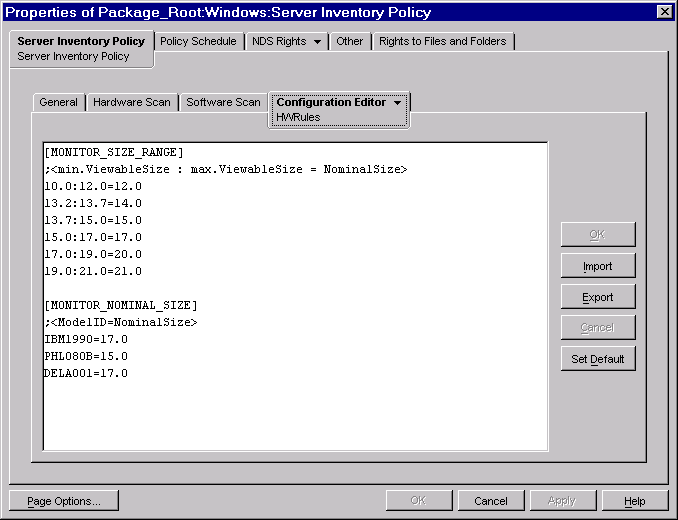16.2 Customizing the Hardware Inventory Information To Be Scanned
ZENworks 7 Server Management allows you to collect information that is not part of the default hardware inventory from the inventoried servers.
16.2.1 Scanning for Vendor-Specific Asset Information from DMI
-
In the Server Inventory policy. click the tab.
For more information, see Section 13.5, Configuring the Server Inventory Policy.
-
Click the suboption, then click .
The following entries are populated.
[ASSETTAG]
DMI1_CLASSNAME=
DMI1_ATTRIBUTEID=
DMI2_CLASSNAME=
DMI2_ATTRIBUTEID=
[SERIALNUMBER]
DMI1_CLASSNAME=
DMI1_ATTRIBUTEID=
DMI2_CLASSNAME=
DMI2_ATTRIBUTEID=
[MODEL]
DMI1_CLASSNAME=
DMI1_ATTRIBUTEID=
DMI2_CLASSNAME=
DMI2_ATTRIBUTEID=
[COMPUTERTYPE]DMI1_CLASSNAME=DMI1_ATTRIBUTEID=
[MODELNUMBER]DMI1_CLASSNAME=DMI1_ATTRIBUTEID=
-
Specify the values.
The Asset Information contains the following sections:
-
Contains Asset Tag in the section [ASSETTAG]
-
Contains Serial Number in the section [SERIALNUMBER]
-
Contains Computer Model in the section [MODEL]
-
Contains Computer Type [COMPUTERTYPE]
-
Contains Computer Model Number [MODELNUMBER]
Each section contains the particular DMI Class name and DMI Class Attribute ID.
The format of Asset Information is as follows:
[ASSETTAG]
DMI1_CLASSNAME=DMI_class_name_for_asset_tagDMI1_ATTRIBUTEID=DMI_attribute_ID_for_asset_tag[SERIALNUMBER]
DMI1_CLASSNAME=DMI_class_name_for_serial_numberDMI1_ATTRIBUTEID=DMI_attribute_ID_for_serial_number[MODEL]
DMI1_CLASSNAME=DMI_class_name_for_computer_modelDMI1_ATTRIBUTEID=DMI_attribute_ID_for_computer_modelThe value of the Asset Information sections can have a maximum string length of 64 characters.
A DMI Class name can be any DMI class other than DMTF|COMPONENTID|00x.
If there is more than one DMI vendor implementing different custom DMI classes, you can specify multiple DMI classes. A maximum of five classes can be specified in these sections. For example, the asset information for five classes is as follows:
[ASSETTAG]
DMI1_CLASSNAME=DMI_class_name_for_asset_tagDMI1_ATTRIBUTEID=DMI_attribute_ID_for_asset_tagDMI2_CLASSNAME=DMI_class_name_for_asset_tagDMI2_ATTRIBUTEID=DMI_attribute_ID_for_asset_tagDMI3_CLASSNAME=DMI_class_name_for_asset_tagDMI3_ATTRIBUTEID=DMI_attribute_ID_for_asset_tagDMI4_CLASSNAME=DMI_class_name_for_asset_tagDMI4_ATTRIBUTEID=DMI_attribute_ID_for_asset_tagDMI5_CLASSNAME=DMI_class_name_for_asset_tagDMI5_ATTRIBUTEID=DMI_attribute_ID_for_asset_tagThe scanner will processes DMI1 and if the values of DMI1 are valid, the scanner will not process the remaining DMI classes.
-
-
Click .
-
Run the scans on the inventoried servers.
Verify that the inventory information is in the Inventory Summary window.
16.2.2 Customizing the Hardware Scanning Information of Jaz and Zip Drive Vendors
The scan information of the vendors for devices such as backup and floppy devices is usually unavailable on the inventoried server. Also, if the information is available, the vendor information does not usually contain the details. You can customize and update information about the vendors of these devices in . The scanners read this information during the hardware scanning process for these devices.
To customize and update the vendor information for display:
-
In the Server Inventory policy, click the tab.
For more information, see Section 13.5, Configuring the Server Inventory Policy.
-
Click the suboption, then click .
The default values are displayed.
[Identifier]
iomega ZIP 100=Iomega 100MB Backup Device
iomega jaz 1GB=Iomega 1GB Backup Device
IOMEGA ZIP 100 D.13=Iomega Corporation
IOMEGA ZIP 1GB D.13=Iomega Corporation
...
The format of each entry in the section is as follows:
[Identifier]
device_id=vendor_display_name_you_specifywhere device_id is the unique ID generated and updated in the registry by the vendor during the installation of the device on the inventoried server.
For example, the contents of the section are as follows:
[Identifier]
iomega ZIP 100=Iomega 100MB Backup Device
This entry is for a 100 MB Zip* drive installed on the inventoried server.
-
Add or modify the entries.
If you specify incorrect values for the device ID entry, the device will not be displayed in the Inventory windows.
-
Click .
16.2.3 Customizing the Hardware Information for Monitor Size
The inventory information scanned for a monitor includes the following:
Nominal Size: A number representing the diagonal width of the monitor (the distance from one corner of the screen to the opposite corner of the screen). For example, 17".
Viewable Size: A number representing the diagonal width of the screen image excluding the black borders around the image's edge. For example, 15.8".
The Inventory scanner automatically scans for the viewable size of the monitor of Windows* inventoried servers. Using the Server Inventory policy, you can customize the nominal size of the monitor to be reported.
IMPORTANT:The Inventory scanner reports inventory information for the monitors that are manufactured only after 1997.
To customize the scan of the nominal size of the monitor:
-
In the Server Inventory policy, click the tab, then click the suboption.

-
Click .
The default values are displayed in the Configuration Editor box.
-
Add or modify the entries.
The format of HWRules.ini is as follows:
[MONITOR_SIZE_RANGE]
minimum_viewable_size_you_specify: maximum_viewable_size_you_specify = nominal_size_you_specify
[MONITOR_NOMINAL_SIZE]
model_ID_reported_by_scanner = nominal_size_you_specifyIn the [MONITOR_SIZE_RANGE] section, specify the minimum and maximum range of the viewable size, and the corresponding nominal size of the monitor. The Inventory scanner scans for the model ID of the monitor and reports the nominal size configured in the [MONITOR_NOMINAL_SIZE] section of the HWRules.ini file.
In the [MONITOR_NOMINAL_SIZE] section, specify the model ID and its corresponding nominal size as reported by the Inventory scanner. This information is available in the Inventory Summary dialog box under the Hardware/Software Inventory > Hardware > Monitor attribute.
If the scanned model ID is not listed in [MONITOR_NOMINAL_SIZE], then the scanner scans the viewable size of the monitors. On the basis the viewable size, the scanner reports the nominal size configured in the [MONITOR_SIZE_RANGE] section of the HWRules .ini file.
For example, the contents of the HWRules .ini file could be as follows:
[MONITOR_SIZE_RANGE]
10.0:12.0=12.0
13.2:13.7=14.0
[MONITOR_NOMINAL_SIZE]
IBM1990=17.0
PHL080B=15.0
-
Click to save the contents to the Server Inventory policy.